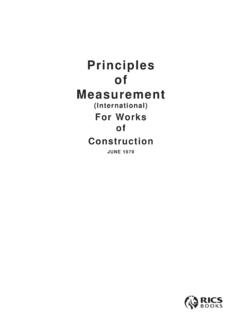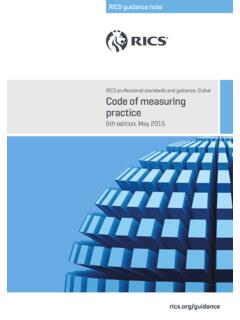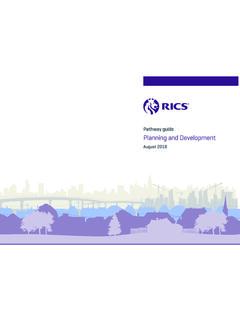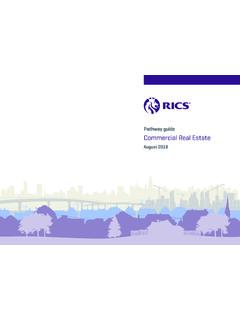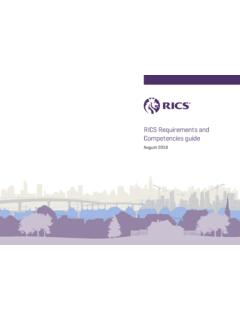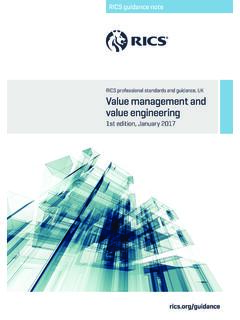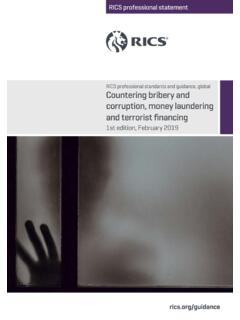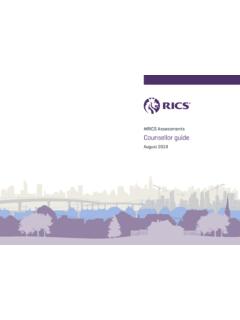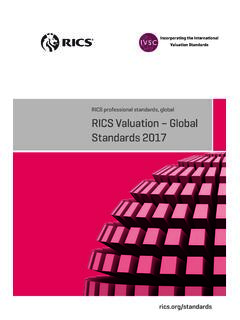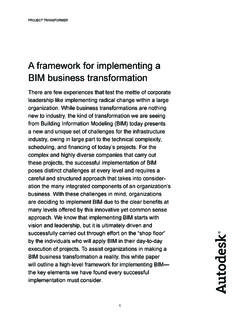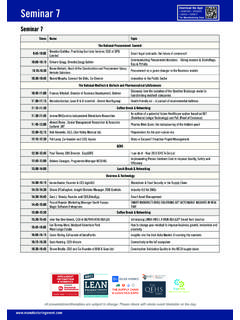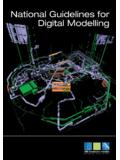Transcription of Pathway guide Building Surveying - rics.org
1 Pathway guideBuilding SurveyingAugust 2018 Pathway guide2 Building SurveyingPublished by: RICS, Parliament Square, London SW1P 3AD. All rights in this publication, including full copyright or publishing right, content and design, are owned by RICS, except where otherwise described. Any dispute arising out of this publication is subject to the law and jurisdiction of England and WalesDate published: March 2018 Version guide3 Building SurveyingBuilding SurveyingSection oneIntroduction ..5 About the competencies ..5 Choosing your competencies ..5 Where to find help ..5 Section two About the Pathway ..6 About the RICS qualification ..6 Chartered alternative designations ..6 Section threePathway requirements ..7 Section fourTechnical competencies guidance ..8 Building information modelling (BIM) management ..8 Building pathology ..9 Client care ..10 Commercial management ..12 Conflict avoidance, management and dispute resolution procedures ..13 Conservation and restoration.
2 15 Construction technology and environmental services ..16 Contract administration ..17 Contract practice ..18 Pathway guide4 Building SurveyingDesign and specification ..19 Design economics and cost planning ..20 Development/project briefs ..21 Fire safety ..22 Health and safety ..23 Housing maintenance, repair and improvements ..24 Inclusive environments ..25 Inspection ..26 Insurance ..27 Landlord and tenant ..28 Legal/regulatory compliance ..29 Maintenance management ..30 Measurement ..31 Procurement and tendering ..32 Project finance ..33 Quantification and costing ..34 Risk management ..35 Sustainability ..36 Works progress and quality management ..37 Pathway guide5 Building Surveying2143 This guide supports the Building Surveying Pathway . It is designed to help you understand more about qualifying in this area. You must use this guide in conjunction with the core assessment documentation which is available on the RICS website and comprises of: Requirements and competencies guide Candidate guide for your RICS assessment APC, Academic, Senior Professional, Specialist Counsellor can download all the supporting guidance from All RICS pathways are global, though it is appreciated that markets may vary from country to country.
3 If you have any queries please contact your local office. About the competenciesThe RICS competency framework ensures those applying for the RICS qualification are competent to practise and meet the highest standards of professionalism required by RICS. There is a wide range of pathways available to qualify as an RICS professional covering many different areas of practice. IntroductionThe RICS assessment aims to assess that you are competent to carry out the work of a qualified chartered surveyor. To be competent is to have the skill or ability to perform a task or function. The RICS competencies are also based upon attitudes and behaviours. The competencies are presented in a generic way so they can be applied to different areas of practice and geographical locations. It is important that you interpret them within the context of your own area of practice or specialism and location. Each competency is defined at three levels of attainment. You must reach the required level in a logical progression and in successive 1 knowledge and understanding Level 2 application of knowledge Level 3 reasoned advice, depth and synthesis of technical knowledge and its competencies are in three distinct categories:Mandatory the personal, interpersonal, professional practice and business skills common to all pathways and mandatory for all core the primary skills of your chosen optional Selected as additional skill requirements for your Pathway from a list of competencies relevant to the area of mandatory competency requirements are set out in detail in the Requirements and competencies your competencies It is important that you give careful thought to your choice and combination of competencies.
4 Your choice will inevitably reflect the work you do in your day-to-day environment (driven by the needs of your clients/employer). Your choice and combination of competencies will be a reflection of your judgement. At the final assessment interview, the assessors will take these choices into account. They will expect you to present a sensible and realistic choice that reflects the skills needed to fulfil the role of a surveyor in your field of guide should help candidates and employers with a degree of assistance in choosing the competencies that are most appropriate to their area of to find helpRICS has fully trained teams across the globe who will be able to help you with any queries. For details of your local office guide6 Building Surveying2143 Building Surveying is one of the widest areas of Surveying practice. Chartered Building surveyors are involved in all aspects of property and construction from supervising large mixed-use developments to planning domestic extensions.
5 This varied workload can include everything from the conservation and restoration of historic buildings to contemporary new surveyors work in most real estate markets including residential, commercial, retail, industrial, leisure, education and health. Consequently, there are a wide variety of opportunities for chartered Building surveyors to work in both the commercial, private, and public sectors. Many chartered Building surveyors work for property consultancies, public sector organisations, real estate owning clients and contractors as well as in a number of specialist niche areas such as insurance, rights to light, party wall matters well as strong technical skills, Building surveyors need to have strong people skills and the highest levels of integrity. Clients, whether a large corporation or an individual member of the public, need to have the utmost confidence in the impartial advice given by chartered Building Building surveyors are clearly differentiated from the rest of their market by their enhanced technical knowledge and professional standards.
6 Achieving the chartered status will enhance your professional status with employers and clients alike leading to more and varied employment qualification Building surveyors provide professional technical advice on land, property and construction for commercial companies and consultants, central and local government, and private sector they work in, Building surveyors knowledge and understanding of construction technology and Building pathology means they are ideally equipped to provide a wide range of services including the following: Managing design and construction Undertaking Building surveys and measured surveys Analysing design and Building defects Preparing strategies for asset management and property maintenance Preparing insurance valuations and claims Preparing strategic property advice covering land ownership, lease conditions, boundaries, title matters (including easements, licences and covenants etc.), and landlord and tenant legislation Project management and development monitoring Miscellaneous services including accessibility and energy audits, specialist surveys (asbestos, damp etc.)
7 , conservation advice and sustainability alternative designationsAll candidates qualifying through this Pathway will be entitled to use the designation Chartered Building Surveyor . RICS also offers a Building Surveying Pathway as part of the Associate Assessment. For further details please go to the pathwayPathway guide7 Building Surveying2143 Pathway requirementsLevel 3 Building pathology Construction technology and environmental services Contract administration Design and specification Inspection Legal/regulatory complianceLevel 1 Fire safetyCoreLevel 3 Ethics, Rules of Conduct and professionalismLevel 2 Client care Communication and negotiation Health and safetyLevel 1 Accounting principles and procedures Business planning Conflict avoidance, management and dispute resolution procedures Data management Diversity, inclusion and teamworking Inclusive environments SustainabilityMandatoryTwo to Level 2 BIM management Commercial management Client care (to level 3), or Conflict avoidance, management and dispute resolution procedures or Health and safety (to Level 3)
8 Or Inclusive environments or Sustainability Conservation and restoration Contract practice Design economics and cost planning Development/project briefs Fire safety Housing maintenance, repair and improvements or Maintenance management Insurance Landlord and tenant Measurement Procurement and tendering Project finance Quantification and costing Risk management Works progress and quality managementOptionalPlus one to Level 2 from the full list of technical competencies, including any not already chosen from the optional list. Pathway guide8 Building Surveying2143 Building information modelling (BIM) management This competency encompasses the establishment and management of the information modelling systems on projects. It covers collaborative process and technological principles involved in implementing Building information modelling (BIM).Examples of likely knowledge, skills and experience at each levelLevel 1 Level 2 Level 3 Demonstrate knowledge and understanding of the technical, process and collaborative aspects of the use of BIM on and apply management systems to facilitate the use of BIM on projects including unified control and reporting how the knowledge and experience gained in this competency has been applied to advising clients and/or senior management on BIM of knowledge comprised within this level are: BIM strategies and implementation The various technical options and solutions for information modelling The collaborative processes necessary for BIM adoption Standard classification systems and their use in infrastructure Relevant internationally recognised management standards such as Construction Operations Building information Exchange (COBie).
9 Examples of activities and knowledge comprised within this level are: Preparation of a BIM execution plan Design and implementation of a BIM management process Analysis of comparative BIM solutions Maintenance of an information model Agree and implement contractual aspects of BIM such as separate protocol Facilitate and manage project team members for BIM of activities and knowledge comprised within this level are: Analysing, assessing, evaluating and reporting on options for BIM strategies at a corporate or project level Designing and advising on collaborative strategies for the successful implementation of BIM on projects Advising on the contractual and commercial implications of using BIM on projects Advising on options for software and protocols on BIM projects Advising on technical information systems requirements for BIM at corporate or project competencies guidancePathway guide9 Building Surveying2143 Building pathology Building Pathology is core to many areas of Surveying .
10 It is essential that all candidates have an understanding of defects analysis, and the likely resultant defects from failures in Building fabric. This will range from the effects of a defective waterproof covering at simple Building pathology, to much more complex defects such as interstitial condensation, and the possible effects on Building fabric. Candidates will be expected to have an in-depth knowledge of the range of defects found in typical buildings in their locality, as well as an understanding of defects that they may come across more infrequently. In order to be competent in Building pathology and defects analysis, candidates will need to have detailed construction technology knowledge. Examples of likely knowledge, skills and experience at each levelLevel 1 Level 2 Level 3 Demonstrate your knowledge and understanding of Building defects. Apply your knowledge to undertake sur veys, use sur vey and other information to diagnose cause and mechanisms of reasoned advice and appropriate recommendations, including the preparation and presentation of of knowledge comprised within this level are: On typical Building defects explain cause and effect of these for example, dampness, timber defect, Building movements Building defects likely to be encountered in typical Building Surveying activities Differing types of testing, and the limitations of the tests, for example the use of damp meters, and borescopes Construction detailing of different Building types and through ages of of activities and knowledge comprised within this level are.
